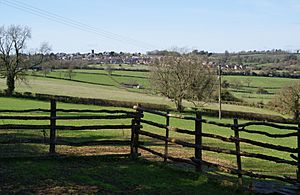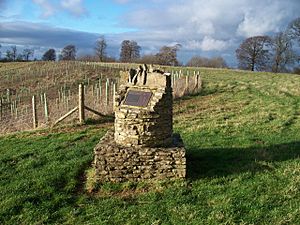Battle of Stow-on-the-Wold facts for kids
Quick facts for kids Battle of Stow-on-the-Wold |
|||||||
|---|---|---|---|---|---|---|---|
| Part of First English Civil War | |||||||
 |
|||||||
|
|||||||
| Belligerents | |||||||
| Commanders and leaders | |||||||
| Sir Jacob Astley | Sir William Brereton Colonel Thomas Morgan |
||||||
| Strength | |||||||
| 3,000 foot 500 horse |
2,500 foot 600 horse |
||||||
| Casualties and losses | |||||||
| Less than 1,000 killed 1,000 captured |
Light | ||||||
The Battle of Stow-on-the-Wold happened on March 21, 1646. It was one of the last big battles of the First English Civil War. In this battle, the Parliamentarians won a major victory. They defeated the very last main army of the Royalists. The Royalists were supporters of King Charles I of England. The Parliamentarians supported the Parliament.
By early 1646, King Charles I was in a tough spot. His Royalist forces were losing ground. He hoped for help from other countries. Meanwhile, Sir Jacob Astley, a skilled Royalist general, tried to gather a new army. He pulled together about 3,000 soldiers from different Royalist strongholds. These soldiers were tired, and their spirits were low. But Sir Jacob was a strong leader. He aimed to take his new army to Oxford, where the King was. However, Parliamentarian forces stopped him at Stow-on-the-Wold.
Contents
Why the Battle Happened
The King's Difficult Situation
The year 1646 started very badly for King Charles I. He had almost no army left. It was hard to raise new troops. His money, weapons, and supplies were nearly gone. Even worse, the Royalists were not united. There were disagreements among them. Everyone, both Royalists and Parliamentarians, knew the war was causing great suffering. They saw that continuing the fight would not help anyone.
Sir Jacob Astley's Mission
Sir Jacob Astley left Oxford in December 1645. His job was to visit different Royalist garrisons. These were places where soldiers were stationed. He wanted to gather enough men to form a new army. This was a very hard task. He also had very little money. If he had more money, he could have built a stronger force. Instead, he had to work with soldiers who were not always well-behaved.
Astley arrived in Worcester in early 1646. One of his first actions was to help the Royalist garrison at Madresfield. This garrison had been under attack for months. Astley and his men drove off the attackers.
Parliament's Growing Strength
The Parliamentarians were getting stronger. In February 1646, Chester surrendered to them. This was a big blow to the Royalists. It meant a large Parliamentarian force was now free. These soldiers could now join the fight against other Royalist strongholds.
Sir Jacob Astley wanted to reach King Charles I in Oxford. But Parliamentarian armies blocked his way. Sir Thomas Morgan, the governor of Gloucester, had a strong force. John Birch, governor of Hereford, also had many soldiers. And Sir William Brereton was moving up behind Astley. Astley was being squeezed from all sides.
Astley's Difficult March
Astley gathered about 3,000 men at Bridgnorth. He even had to borrow money from the town to pay his own costs. Many of his soldiers were "reformado" officers. These were officers whose regiments no longer existed. They were desperate men. They had little to lose and hoped to gain from fighting.
Astley marched from Bridgnorth to Kidderminster. There was a small fight near Kidderminster. Then, he moved to Worcester. He knew Morgan and Birch were waiting for him. Brereton was also closing in from behind. Astley had to cross the River Avon. He also needed to get past the Parliamentarian garrison at Evesham.
Astley tried to trick his enemies. He sent some men towards Evesham. But his main army marched back to Droitwich Spa. This made Brereton think Astley was going to attack him. Then, Astley quickly moved across the countryside. He crossed the River Avon at Bidford and Cleve Prior. He marched past Morgan's flank. He headed towards Campden, Blockley, Bourton-on-the-Hill, and finally, Stow-on-the-Wold.
The Battle of Stow
On March 20, Morgan realized Astley had outsmarted him. Morgan's men attacked Astley's rearguard. They harassed and slowed down Astley's march. This gave Birch time to get in front. It also allowed Brereton to catch up from behind. Astley pushed on and reached Donnington. This village is about two miles from Stow-on-the-Wold.
Astley chose a small hill west of Donnington for his final stand. Brereton had now arrived. Morgan attacked the tired Royalists in the dark. It was two hours before dawn on March 21. Birch attacked from the front. Morgan attacked from the rear. They tried to surround the Royalists. Morgan charged Astley's rear with 200 gunmen and 400 horsemen. He was pushed back twice. Astley almost broke through the circle of enemies.
But as Astley pushed through Morgan's men, Birch pressed his attacks from the front. Still, Astley's men fought bravely. Birch's horse was shot from under him. His regiment lost 32 men. The Royalists fought a slow retreat into the streets of Stow. Despite their efforts, the Parliamentarian circle tightened around Astley. Finally, some Royalists broke ranks and fled. Birch's horsemen rode through the gaps. There was nothing left but to surrender.
What Happened Next
With this surrender, the last Royalist field army was gone. Many important Royalist leaders were captured. These included Lord Astley, Sir Charles Lucas, and Colonel Corbet. Out of Astley's 3,000 men, Morgan captured 1,600 prisoners. Many were killed or wounded. The rest scattered. Those who tried to escape were often caught. They were cut down by Parliamentarian soldiers. All the Royalist weapons and supplies were taken.
The defeat was complete. Astley's force, which he had gathered with such care, was destroyed. Astley knew it. He was exhausted from the marches and the fight. He sat on a drum and spoke to Morgan's men. He said:
You have done your work, boys, and may go play, unless you will fall out among yourselves.
This was a sad but fitting end to the last major battle of the First Civil War. It came from a man famous for his soldier's prayer at the first big battle. After this, King Charles could not raise any more large armies. The Parliament only had to capture the few remaining Royalist strongholds. Once that was done, their military victory was complete.
Legacy
Inside St. Edward's Church in Stow-on-the-Wold, there is a monument. It remembers Sir Hastings Keyte. He was a Royalist captain who died in the battle at just 23 years old.


